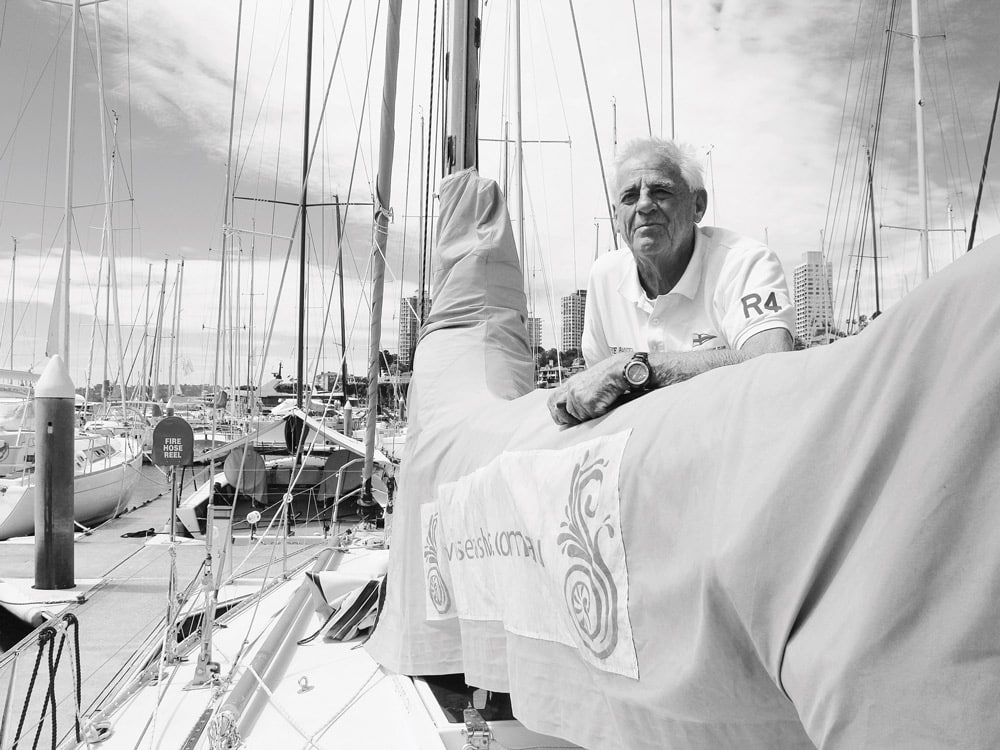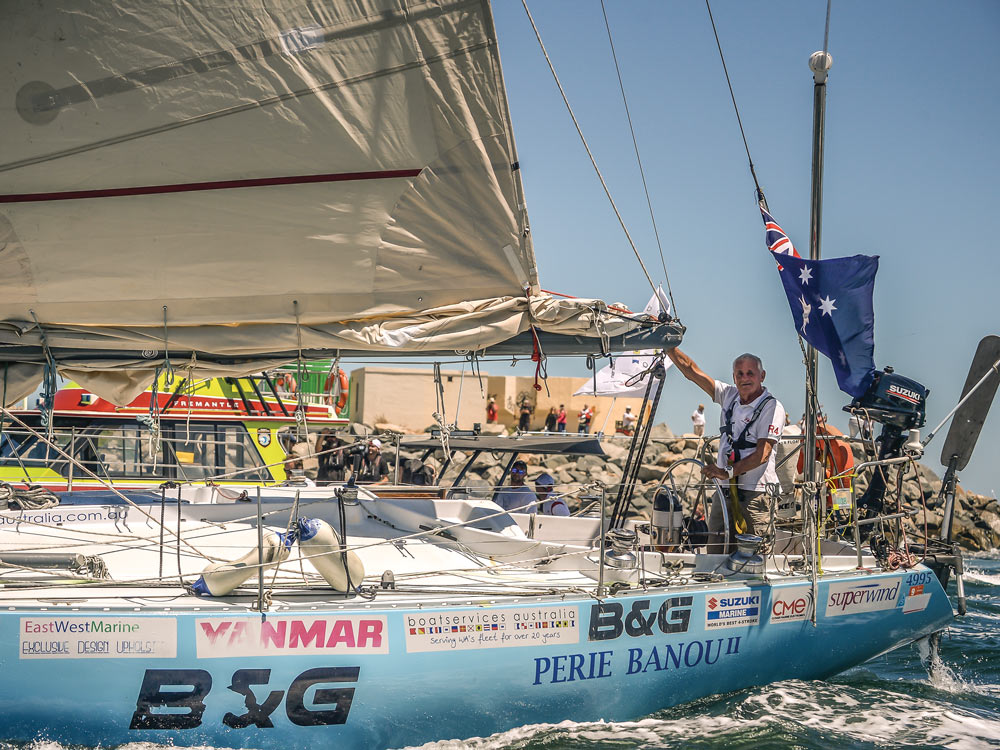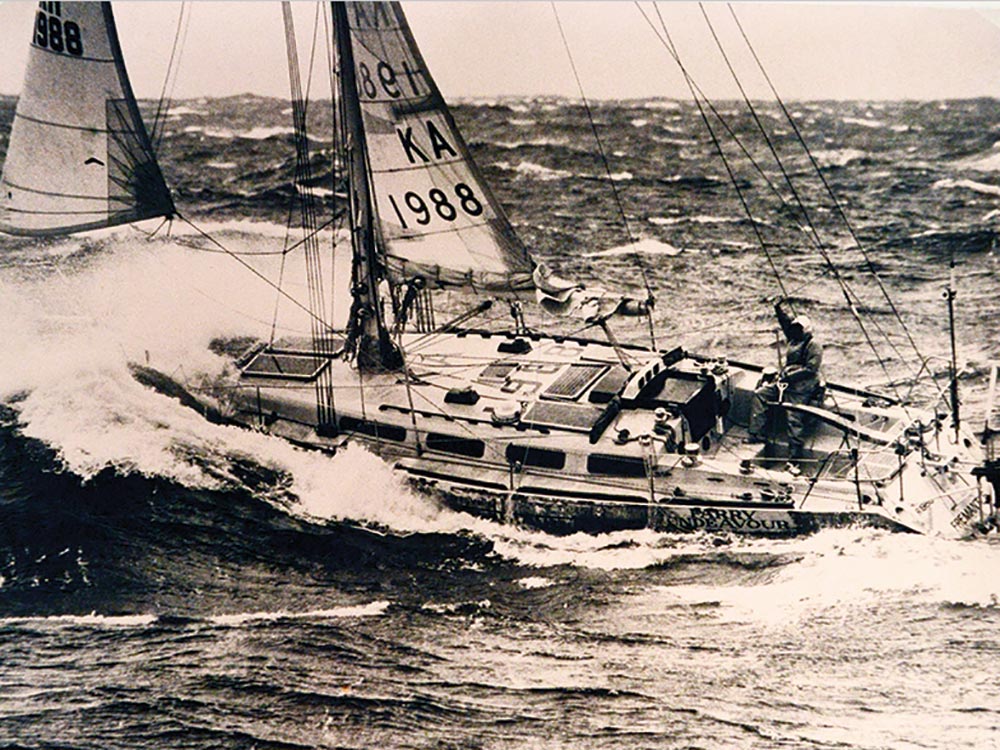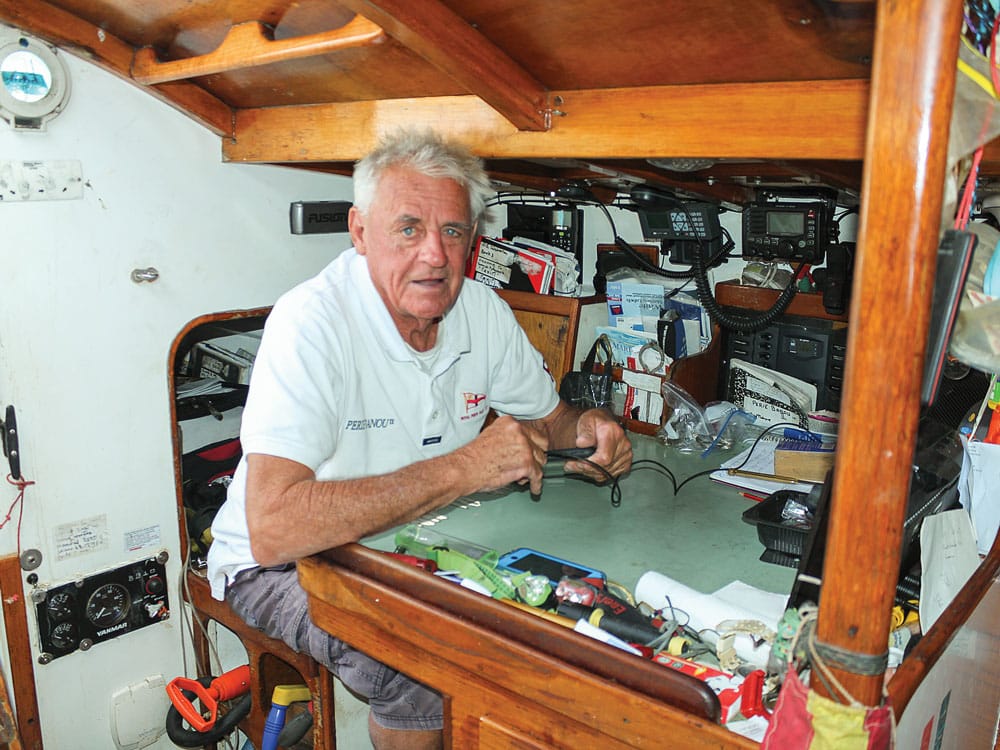
Walking down the dock at Sydney’s Cruising Yacht Club of Australia, I nervously approached the pale-blue yacht, noting its pronounced tumblehome that harked back to another era. At first glance, Perie Banou II was a fairly ordinary-looking IOR-style design, but the logos emblazoned along its topsides and the heft of its deck gear confirmed that it was no ordinary Sparkman & Stephens 39. Its skipper, Jon Sanders, had just called into Sydney on one of the last stops of his remarkable 10th circumnavigation before crossing the Australian Bight to his home waters of Perth. As I stepped aboard, he laughed and said, “This will be my 47th crossing of the bight.”
Singlehanders have a reputation for awkwardness or downright grumpiness as I remember with the late Tristan Jones and John Ridgeway, but the tall and spritely Sanders immediately disarmed me with his easy charm and friendly manner. His piercing blue eyes, lightly tanned face and thick thatch of hair made it hard to believe he’s 78 years old and a survivor of open heart surgery only two years ago.
“I never get out of puff on the boat, but when I walked up that hill behind the yacht club I did get a little tired,” he said. The only difference seen in earlier pictures that he sent me — which he took on a previous voyage by self-timer while becalmed off Cape Horn — is his dark hair. Sanders has rounded the Horn five times while completing both east and west circumnavigations.
Some singlehanded sailors have a reputation for grumpiness, but not the tall, charming, friendly Jon Sanders.
On this journey, he avoided the Horn, setting off from Perth in October 2016 and later transiting the Panama Canal. His modesty belies a determined appetite for ocean voyaging, which includes several outstanding records, the greatest being his solo, nonstop triple circumnavigation from 1986 to 1987. This remains the longest distance — 71,023 nautical miles — ever sailed continuously by any sailor unassisted and alone; it took 678 days at sea and earned Sanders an Order of the British Empire (OBE) and the coveted Blue Water Medal from the Cruising Club of America. While working in Perth a few years ago, I visited that record-breaking boat, a 46-foot Curran sloop named Parry Endeavour, in the Western Australian Maritime Museum. Along with the 1983 America’s Cup winner, Australia II, it’s one of the museum’s prized exhibits.

“This trip is my swan song,” he said while sitting below aboard Perie Banou II. A confirmed bachelor, he’s close to his brother, Colin, whom he stays with when ashore. Like some of the other solo sailors I’ve met, such as six-time circumnavigator Webb Chiles, I got the impression that shore time for Sanders serves as a rather mundane gap between sea time. Unlike Chiles, who has been married six times, the sea is perhaps a steadier mistress for Sanders, one that takes him to favorite ports such as the British Virgin Islands and, on this voyage, New Caledonia.
Sanders’ S&S 39 was built in Sydney in 1971. “It’s the second-stiffest boat in the whole of Western Australia, according to the stats,” he said. “The lead keel weighs nearly half of the boat.” It’s taken a few tumbles over the years. “She went right over once, but I held on, sitting on the cabin sole, and she righted herself fairly easily,” he said.

Walking around the deck, I noticed that most fittings, like the huge hinges on the main skylight, were oversize. “It can open both ways,” he said. Sanders still fondly recalls his first seagoing yacht, a Sparkman & Stephens 34 called Perie Banou, the name of a fairy in the book The Arabian Nights, which his mother — the well-known Western Australian writer Dorothy Lucy McClemans — was fond of (under the pseudonym Lucy Walker, she wrote 42 books). She, along with his father, an academic, encouraged Sanders’ sailing, and by the age of 14, with his brother and sister, Lucy-Anne, he owned his first sailboat. His late mother’s estate has helped him fulfill his sailing dreams. “She left me a small legacy, which works out like a pension and has given me a bit of money to go on with,” he said.
“There’s no grog on board when I’m sailing,” Sanders said with a laugh. “At my age I might not wake up for my watch.”
Perie Banou II has a fairly conventional Bermudan rig with a roller-furling headsail and slab reefing on the mainsail, but the deck-stepped spar also has a tabernacle for raising and lowering. Sanders runs downwind under the main alone, on a preventer, with the headsail furled. When I asked about the twin spinnaker poles lashed to the gunwales, he said, “On other trips I’ve run with twin headsails, but I didn’t use them this time.” At 78, safety and comfort are high priorities: “I’m in no hurry, so I always sail with one reef in the main now, which allows me to sleep for 20 minutes at a time. I don’t need alarms to wake me; my body does it itself.” There are three reefing points in the main. “And the third one is like a trysail — it’s been up in 50 knots and was fine.”
Sanders doesn’t engage dedicated meteorologists and weather routers, unlike younger Aussie circumnavigators Jessica Watson and Jesse Martin. “I watch the barometer!” But his approach is far from old school.
“I have the iPad connected to the Iridium satellite for emails and comms,” he said. One of his major sponsors, Navico, installed most of the navigation gear for this trip, including a B&G chart plotter, VHF/AIS-radio and a Simrad tillerpilot. “The tillerpilot is ideal when I’m motorsailing, and the Aries windvane handles the rest,” he said.
In the cluttered confines of his saloon, there’s memorabilia from all over the world. One of the plates above the chart table is a certificate from his last transit of the Panama Canal (his seventh), and another plate commemorates his participation in the Cape Town to Rio de Janeiro race (he’s done two). Sanders usually sleeps on the port saloon bunk, equipped with both a lee cloth and a cup holder for his usual can of Pepsi. His galley is a two-burner gimbaled stove with a big gap beneath it. “I had an oven there that I used to bake bread in, but took it off for this trip because I’m not eating so much.” Instead, his meals mostly consist of dehydrated fare.

After the tour of the boat, we retired to the bar at the CYCA. “There’s no grog on board when I’m sailing because at my age I might not wake up for my watch!” he said, laughing. Back home, he’s usually seen puttering around the pontoons of the Royal Perth Yacht Club, another major sponsor.
“Jon is really easy to work with, and he’s just a great man,” said the club’s Kelly Scott.
As host club for the annual Rolex Sydney Hobart yacht race, the CYCA was a busy place, but a few of the sailors stopped by to say hello, though the majority had no idea about the identity of this tall, innocuous mariner. I sort of felt sorry for them.
The conversation shifted to motorcycles, and when he noticed my Yamaha dirt bike parked behind the club he confessed that a road in Perth was named after him. So he’s not exactly anonymous back home.
After a few pints of beer, Sanders glanced at the acres of shiny fiberglass floating along the pontoons and said, “I’d like that big Beneteau 60 over there. With the thrusters and all the luxury accommodations, it would be perfect for my retirement!” When I asked him if he would ever really retire from ocean sailing, he said, “Oh, maybe. Then again, I might just sneak off again one day without letting them know I’m gone. Not until I call them from Malaysia or someplace!”
Kevin Green is a writer, sailor and editor based in Sydney, Australia. For more on Jon Sanders, including his history of record-setting voyages, visit his website.








